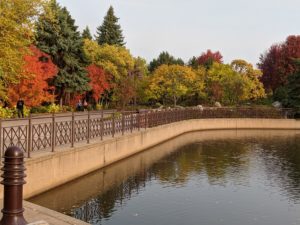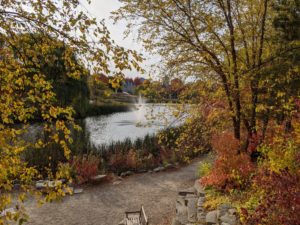With increasing urban development and a changing climate, city governments need to consider new ways to manage stormwater. “It’s not easy being green,” a recent paper from the University of Minnesota, reviews different approaches to green stormwater infrastructure.
Stormwater management is especially important in older cities that have combined sewer systems rather than separate sanitary- and stormwater sewers. That’s because heavy rains can overload a combined sewer. And with climate change, we’re seeing more frequent major storms. When that happens, the untreated overflow contaminates surface waters. But installing separate sewer systems is often too costly for city budgets, even with federal assistance. Green stormwater infrastructure offers a less expensive alternative for improving water quality.
Green stormwater infrastructure helps regulate the flow of stormwater so it doesn’t all run off at once. It also uses natural processes to remove contaminants from the water. Appropriate practices may help projects comply with the provisions of CALGreen. However, it’s important to consider the positive and negative ramifications of each approach.
Who benefits?
A related concern is that infrastructure doesn’t necessarily benefit all communities. This is not a new problem. For example, in the 19th century the adoption of flush toilets in the United States led to the construction of combined sewers in many cities. Downstream cities experienced epidemics of typhoid and cholera as a result, with the poor and people of color suffering disproportionately.
“Gray infrastructure” such as sewers has a long history of unequal outcomes, including flooding and contamination of drinking water in communities of color.
But green infrastructure is not free of inequities. It’s important to listen to the needs of all communities in planning such projects. Because of past experience, the poor and people of color may be less receptive to green stormwater infrastructure than you’d expect. One concern is that these projects generally increase the value of local real estate. It may be a nicer place to live, but they can’t afford the rent any more. Or poor communities may not have the budget to maintain their infrastructure, with the result that it deteriorates with age. In some cases that means the final outcome is worse than if they’d done nothing at all.
Urban trees

Trees mitigate urban heat island effects, intercept rainfall, promote evapotranspiration, stabilize soil, and reduce erosion. They can also provide habitat for birds and animals. However, the organic material they produce—particularly leaves, nuts, and pollen—may be problematic.
Depending on the species of tree, its pollen can aggravate allergies and asthma—effects that fall disproportionately on Black and Puerto Rican residents. If rainfall is less than the rate of evapotranspiration, the soil may subside, potentially damaging structures. Tree roots can infiltrate sewer pipes and damage sidewalks.
Leaves, nuts, and other organic matter also contain nutrients. That’s fine if you’re mulching your garden, but not if it washes directly into the groundwater. Additional, well-timed sweeping of streets is a cost-effective way of keeping phosphorus and mercury out of the groundwater. However, “cost effective” doesn’t mean “free”. If you want trees to benefit the community and the environment, you need to budget for this and other maintenance. You also need to ensure that all communities get to enjoy nearby trees and green spaces.
In addition to trees, other plants can also help manage excess water. The Big U incorporates salt-tolerant landscaping as part of its design to manage storm water and storm surges from the Atlantic.
Stormwater ponds

Stormwater ponds collect rainwater runoff and store it temporarily, allowing time for suspended solids to settle. Occasionally it’s necessary to dredge the sediment from the bottom. If organic matter or contaminants wash into the pond, they will accumulate, and, under certain conditions, eventually infiltrate the groundwater. The most effective way to prevent this contamination is to intercept it before it reaches the pond, whether by street sweeping or pretreatment of certain effluents at the source.
Because frequent maintenance isn’t necessary, ponds may not permit easy access. Overgrown vegetation surrounding the pond further impedes access and shelters it from the wind, which is necessary for mixing and aeration. It may be necessary to remove some trees to open a corridor for prevailing winds. In-pond aeration is also effective.
Stormwater ponds don’t necessarily add to local property values. They can be a safety hazard. And if they’re not properly maintained, they may emit odors, foster harmful algal blooms, or become breeding grounds for mosquitoes.
Infiltration practices
Infiltration allows stormwater to percolate slowly into the ground rather than run off rapidly. The ground itself provides natural treatment to the water, filtering out certain contaminants.
Pervious concrete pavements are an example of an infiltration practice. The subbase must provide a place for the water to go, whether into a sandy soil or a drainage structure. Pervious concrete pavements require maintenance to prevent clogging. They also require proper design and construction, particularly in freezing climates. Beton can help you design and specify a pervious concrete pavement.
This video shows how pervious concrete prevents rapid runoff.
Rain gardens and green roofs
Rain gardens are a form of infiltration practice with the addition of well-chosen plants and trees to promote biodegradation of certain contaminants. They can remove hydrocarbons, pesticides, toxic metals, nutrients, suspended solids, and bacteria from stormwater. However, they may also add phosphorus to the water.
A green roof is similar to a rain garden, but is located on a roof. It receives rainwater only, which has relatively few contaminants compared to stormwater runoff. However, overuse of compost or fertilizers could contaminate the rainwater. A green roof should absorb the rainwater it receives except in heavy rain. That is, it doesn’t normally allow for infiltration. However, it does provide other benefits. These include heat island mitigation, thermal- and noise insulation, and improvements in air quality. And it reduces runoff because the rainwater stays on the roof. Excess water should drain onto a lawn or rain garden to avoid contaminating groundwater with nutrients.
If you’re thinking of installing a green roof, don’t forget that the structure and foundation beneath it must support the additional weight of soil, water, and plants. If your structure is made of concrete, you’ll also need to pay attention to the exposure to the chemicals that will leach from the soil and fertilizer. Beton can help you design and specify a durable concrete for this—or any other—purpose.
Making it work
As with anything else you design, green stormwater infrastructure requires careful consideration of all factors. What do you want it to do? What can it do? How much does it cost—both to construct and to maintain? What are the potential effects, both positive and negative? Do you need to mitigate any negative consequences? Have you solicited feedback from the surrounding community?
Beton can help you get the right concrete for the job, whether you want a pervious concrete pavement or one that will withstand exposure to the chemicals in the stormwater runoff.
